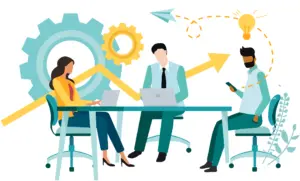The journey from a small, local enterprise to a market-leading success is an exhilarating but challenging marathon. Many businesses stall after the initial launch, unable to break past the constraints of limited resources and local reach. Yet, the blueprint for exponential growth is not reserved for Silicon Valley giants; it’s a strategic, methodical process available to every ambitious entrepreneur.
This in-depth guide provides a comprehensive framework, focusing on sustainable practices and innovative strategies to turn your small business into a big success.
Phase I: Solidifying the Foundation and Mastering the Market
A towering structure requires a deep, unshakeable foundation. For a small business, this foundation is built on absolute clarity about your market, audience, and financial health.
1. Achieve Absolute Market and Customer Clarity (The 360-Degree View)
Before scaling, you must know precisely who you serve and why they choose you over the competition. This goes beyond basic demographics.
- Deep Customer Persona Development: Create detailed profiles of your ideal customers (personas). What are their pain points? What are their aspirations? How does your product or service fundamentally change their life or work? This clarity drives targeted marketing and superior product development.
- Competitor Analysis and Unique Value Proposition (UVP): Study your successful competitors. What are their strengths and, more importantly, their exploitable weaknesses? Define your Unique Value Proposition (UVP) – the single, compelling reason a customer must choose you. Is it superior service, niche specialization, or an innovative, proprietary technology? This UVP must be clearly communicated across all channels.
- Financial Scrutiny and Scalable Pricing: Understand your unit economics—the direct revenues and costs associated with a single unit of your business (e.g., one sale, one client, one product). Ensure your pricing model is not only profitable today but can sustain the increased costs associated with rapid expansion (e.g., hiring, new infrastructure). Reinvesting profits smartly is key, minimizing overhead and focusing capital on growth engines like technology and talent.
2. Operational Efficiency: The Engine of Scalability
A small business often relies on manual, ad-hoc processes. A big business relies on scalable, repeatable systems.
- Systematize and Document Everything (The “Operations Manual”): From customer service workflows to inventory management, document your successful processes. This creates an Operations Manual that is essential for onboarding new employees quickly and ensuring consistent quality as you grow. Systems, not people alone, drive a scalable business.
- Embrace Strategic Automation: Leverage technology to automate repetitive, low-value tasks. This includes Customer Relationship Management (CRM) for sales/marketing, accounting software for financial tracking, and marketing automation for customer engagement. Automation frees up your most valuable resource—your time and your key employees’ time—to focus on strategic growth.
- Build a Culture of Continuous Improvement: Encourage feedback from employees and customers on how to make systems better, faster, and more efficient. Small, incremental improvements compound over time, leading to significant competitive advantages.
Phase II: Digital Dominance and Customer Loyalty
In the modern marketplace, size is often defined by digital reach, not just physical footprint. Your digital strategy is your megaphone to the global market.
3. Leverage Digital Marketing for Wide Reach
Your digital strategy should focus on attracting and converting your precisely defined target audience.
- Content Marketing as a Thought Leader: Create high-quality, valuable content (blog posts, videos, podcasts, guides) that addresses the pain points of your target customer. This establishes your business as a trusted authority, driving organic traffic and building a loyal audience without relying solely on expensive paid ads.
- SEO is Non-Negotiable: Invest time and resources into Search Engine Optimization (SEO). Being highly visible on search engines for relevant, high-intent keywords is one of the most cost-effective, long-term growth strategies.
- Strategic Social Media Engagement: Choose the social platforms where your target audience actually spends their time. Focus on authentic engagement and building a community, not just broadcasting sales messages.
- Build an Email List: Your email list remains your most valuable digital asset. It is a direct line of communication, independent of third-party platform changes, and is critical for nurturing leads and driving repeat business.
4. Transform Customers into Advocates (Retention is the New Acquisition)
Acquiring a new customer can cost significantly more than retaining an existing one. True success is defined by your ability to create lifelong customer advocates.
- Exceptional and Personalized Customer Experience (CX): Every interaction—from a website visit to a post-sale support call—must be intentionally positive. Personalize communication whenever possible. Proactively address issues and view complaints as opportunities to demonstrate your commitment to excellence.
- Implement a Robust Loyalty Program: Reward repeat business. This can be in the form of discounts, exclusive early access to new products, or tiered membership benefits. This formalizes and incentivizes loyalty.
- Actively Solicit and Act on Feedback: Use surveys, direct outreach, and social listening to gather customer feedback. Show customers that their input directly influences your product or service development. This fosters a powerful sense of partnership.
Phase III: Expanding Horizons and Scaling the Team
Scaling requires a shift in mindset from a doer to a leader and from a single product to a diversified portfolio.
5. Strategic Diversification and Expansion
Sustainable growth often involves spreading risk and maximizing your existing customer base.
- Product and Service Expansion: Look for natural, complementary extensions of your current offering. What else do your current, satisfied customers need? This could be a premium version, a related service, or an educational component (e.g., a software company launching consulting services).
- Explore New Distribution Channels: If you’re a brick-and-mortar store, launch an e-commerce platform. If you’re only online, explore strategic wholesale partnerships or pop-up retail experiences. New channels unlock new market segments.
- Strategic Partnerships and Alliances: Identify non-competing businesses that serve the same ideal customer. Form partnerships for co-marketing, cross-promotions, or co-developed products. This allows you to tap into a new audience instantly without a massive marketing budget.
6. Build a High-Performing, Empowered Team
You cannot scale a business alone. Your people are the biggest determinant of your success.
- Hire for Culture Fit and Scalability: Look beyond just skills. Hire individuals who are self-starters, problem-solvers, and who align with your company’s core values. Hire people smarter than you in their respective domains.
- Delegate and Empower: Successful scaling requires the owner to step away from day-to-day tactical tasks. Clearly define roles, trust your team, and empower them to make decisions within their areas of responsibility. Your job shifts to being the visionary and the strategic decision-maker.
- Invest in Training and Development: A commitment to the continuous growth of your employees pays dividends in retention, productivity, and innovation. A motivated, skilled team is your secret weapon against bigger competitors.
Conclusion: The Mindset of Success
Turning a small business into a big success is not about a single grand gesture, but about the relentless, consistent execution of smart strategies. It demands discipline, a customer-centric obsession, and the willingness to evolve. The small business owner who embraces systematization, digital excellence, customer advocacy, and empowered leadership moves from merely surviving to achieving truly exponential and lasting success. The market rewards not the biggest, but the smartest, the fastest, and the most dedicated to solving customer problems at scale.







